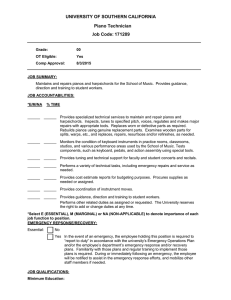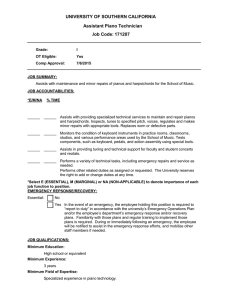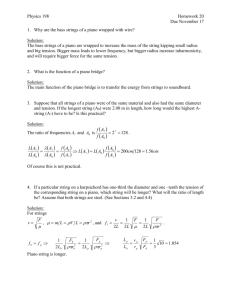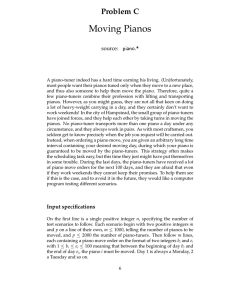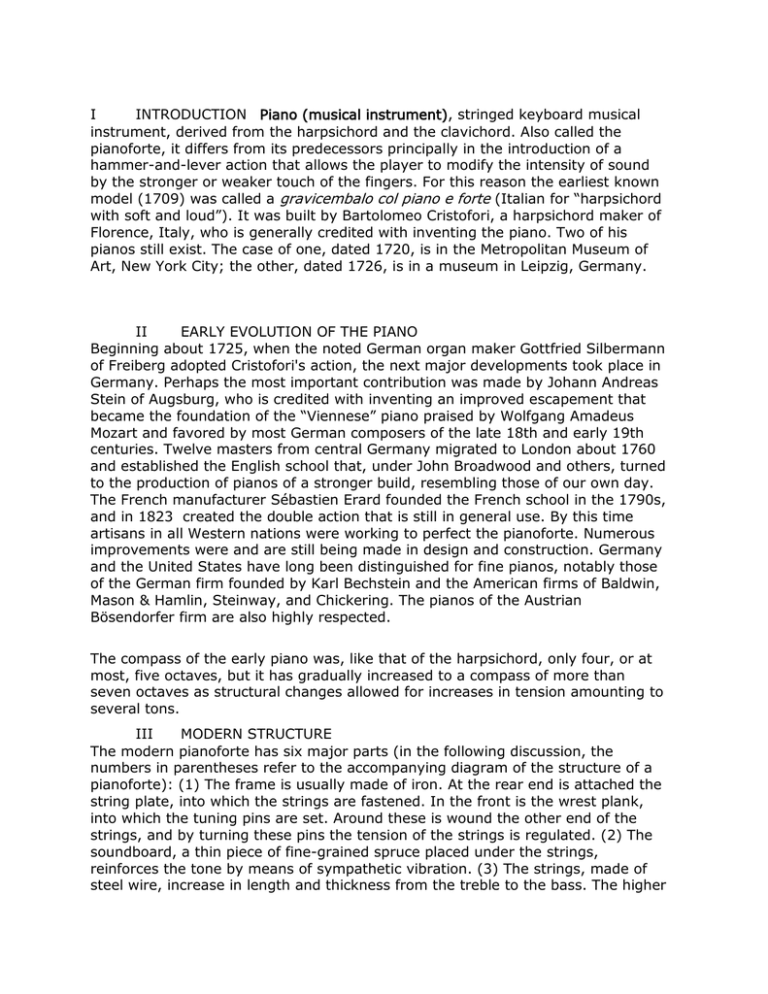
I
INTRODUCTION Piano (musical instrument), stringed keyboard musical
instrument, derived from the harpsichord and the clavichord. Also called the
pianoforte, it differs from its predecessors principally in the introduction of a
hammer-and-lever action that allows the player to modify the intensity of sound
by the stronger or weaker touch of the fingers. For this reason the earliest known
model (1709) was called a gravicembalo col piano e forte (Italian for “harpsichord
with soft and loud”). It was built by Bartolomeo Cristofori, a harpsichord maker of
Florence, Italy, who is generally credited with inventing the piano. Two of his
pianos still exist. The case of one, dated 1720, is in the Metropolitan Museum of
Art, New York City; the other, dated 1726, is in a museum in Leipzig, Germany.
II
EARLY EVOLUTION OF THE PIANO
Beginning about 1725, when the noted German organ maker Gottfried Silbermann
of Freiberg adopted Cristofori's action, the next major developments took place in
Germany. Perhaps the most important contribution was made by Johann Andreas
Stein of Augsburg, who is credited with inventing an improved escapement that
became the foundation of the “Viennese” piano praised by Wolfgang Amadeus
Mozart and favored by most German composers of the late 18th and early 19th
centuries. Twelve masters from central Germany migrated to London about 1760
and established the English school that, under John Broadwood and others, turned
to the production of pianos of a stronger build, resembling those of our own day.
The French manufacturer Sébastien Erard founded the French school in the 1790s,
and in 1823 created the double action that is still in general use. By this time
artisans in all Western nations were working to perfect the pianoforte. Numerous
improvements were and are still being made in design and construction. Germany
and the United States have long been distinguished for fine pianos, notably those
of the German firm founded by Karl Bechstein and the American firms of Baldwin,
Mason & Hamlin, Steinway, and Chickering. The pianos of the Austrian
Bösendorfer firm are also highly respected.
The compass of the early piano was, like that of the harpsichord, only four, or at
most, five octaves, but it has gradually increased to a compass of more than
seven octaves as structural changes allowed for increases in tension amounting to
several tons.
III
MODERN STRUCTURE
The modern pianoforte has six major parts (in the following discussion, the
numbers in parentheses refer to the accompanying diagram of the structure of a
pianoforte): (1) The frame is usually made of iron. At the rear end is attached the
string plate, into which the strings are fastened. In the front is the wrest plank,
into which the tuning pins are set. Around these is wound the other end of the
strings, and by turning these pins the tension of the strings is regulated. (2) The
soundboard, a thin piece of fine-grained spruce placed under the strings,
reinforces the tone by means of sympathetic vibration. (3) The strings, made of
steel wire, increase in length and thickness from the treble to the bass. The higher
pitches are each given two or three strings tuned alike. The lower ones are single
strings made heavier by being overspun—that is, wound around with a coil of thin
copper wire. (4) The action is the entire mechanism required for propelling the
hammers against the strings (see Operation of the Action below). The most visible
part of the action is the keyboard, a row of keys manipulated by the fingers. The
keys corresponding to the natural tones are made of ivory or plastic; those
corresponding to the chromatically altered tones, of ebony or plastic. (5) The
pedals are levers pressed down by the feet. The damper, or loud pedal, raises all
the dampers so that all the strings struck continue to vibrate even after the keys
are released. The soft pedal either throws all the hammers nearer to the strings
so that the striking distance is diminished by one-half, or shifts the hammers a
little to one side so that only a single string instead of the two or three is struck.
Some pianos have a third, or sustaining, pedal that does not raise all the
dampers, but keeps raised only those already raised by the keys at the moment
this pedal is applied. The use of these pedals can produce subtle changes in tone
quality. Many upright pianos have been built in which the application of a pedal
interposes a strip of felt between the hammers and strings so that only a very
faint sound is produced. (6) According to the shape of the case, pianos are
classified as grand, square, and upright. The square form (actually rectangular) is
no longer built. For use in private homes it has been entirely superseded by the
upright, which takes up far less room. Grand pianos are built in various sizes,
from the full concert grand, 2.69 m (8 ft 10 in) long, to the parlor or baby grand,
less than 1.8 m (6 ft) long.
Upright pianos include the late 19th-century cottage piano, of which the upright
grand is merely a larger form. The modern spinet and console pianos are small
uprights related to the cottage piano. In the upright pianos the strings run
vertically, or diagonally, from the top to the bottom of the instrument. Uprights
and small grands are sometimes overstrung; that is, the bass strings are
stretched diagonally across the shorter treble strings, thereby gaining extra length
and improved tone quality. The combined tension of the strings on a concert
grand piano is about 30 tons, on an upright about 14.
IV
OPERATION OF THE ACTION
Essentially, when a piano key is pressed down, its tail pivots upward and lifts a
lever that throws a hammer against the strings for that key's note. At the same
time a damper is raised from these strings, allowing them to vibrate more freely.
The following is a much more detailed description of how the action works; the
numbers in parentheses refer to the accompanying diagram of the action of a
grand piano.
The piano key (1) is a lever that pivots on a balance pin (2). When the player
depresses the key, the tail rises and the capstan screw (3) in the key pushes up
the whippen (4), which is hinged. The free end of the whippen rises, taking with it
an L-shaped piece called the jack, or escapement lever (5), and the repetition
lever (9).
The jack pushes the knuckle, or roller (6), a roll of felt that is fixed to the hammer
shank (7); the hammer thus rises. The jack's upward motion is stopped when its
protruding end hits the regulating button (8). The hammer flies up away from the
jack and strikes the appropriate strings. The repetition lever (9) also rises, but
only until the end where the jack passes through it and touches the drop screw
(10); this lever stays raised until the key is released.
The hammer falls back, but only partway. It is stopped by the knuckle (6) hitting
the raised repetition lever (9). The jack (5) can thus slip back under the partially
raised hammer shank and into its original position. At the same time, the
backcheck (11) keeps the hammer from rebounding against the strings.
If the key is partly released, the hammer moves free of the backcheck, and the
repetition lever stays raised. If the player again depresses the partially released
key, the jack (5) can once more push the knuckle (6) and hammer shank (7)
upward. (This system allows rapid repetition of notes before the key and hammer
have time to return to their original positions. It was an important improvement
over early, simpler piano actions.)
Meanwhile, the tail of the key has also pushed up the damper lever (12), which
lifts the damper (13) off the strings for that key. When the key is even partially
released, the damper falls back onto the strings and silences the note.
When the key is fully released, all parts of the mechanism return to their original
positions because of gravity. Unlike grand pianos, upright pianos cannot rely on
gravity to cause everything to return to place. In a grand piano the action sits
horizontally on the key; in an upright piano the action is adapted so that it sits
more or less vertically. Because it cannot completely rely on gravity, it includes
various springs and small strips of cloth to pull some of the action parts back into
place.
V
EMINENT SOLOISTS
The piano has always been an instrument for virtuosos. Composers played their
own compositions in the 18th and 19th centuries, among them Wolfgang
Amadeus Mozart, Ludwig van Beethoven, Frédéric Chopin, and the Hungarian
Franz Liszt. The noted German pianist Clara Schumann played the compositions of
her husband, Robert Schumann. The end of the century was dominated by the
Russian composer-performer Anton Rubinstein, and in the early 20th century
many performers traveled constantly on concert tours throughout Western Europe
and the United States. Among such performers were the Polish Ignace Paderewski
and the Polish-Americans Josef Hofmann and Arthur Rubinstein. In the period
between World Wars I and II (1918-1939), the Russian-American composerperformer Sergey Rachmaninoff, the Austrian-American Artur Schnabel, the
British Dame Myra Hess, the German Walter Gieseking, and the Brazilian Guiomar
Novaes were popular concert recitalists. After the end of World War II in 1945,
Russian pianists again appeared in the United States, among them Emil Gilels and
Sviatoslav Richter. Perennially popular recitalists included the Chilean Claudio
Arrau, master of a particularly broad repertoire; Rudolf Serkin, a Czech-born
American performer and teacher; the Russian-American virtuoso Vladimir
Horowitz; and the Spanish Alicia de Larrocha. Other highly accomplished players
who appeared after World War II included the Austrian-English Alfred Brendel,
whose scholarly approach aroused some aesthetic controversy; the Canadian
Glenn Gould, whose recordings of Bach won great acclaim; the Americans Van
Cliburn, André Watts, and Murray Perahia; and the Russian-born Vladimir
Ashkenazy, later a citizen of Iceland. Today, with the level of technical proficiency
among pianists rising, an increasing number of international piano competitions
generate wide interest and serve to launch the careers of promising artists.
1
1"Piano (musical instrument)."Microsoft® Encarta® Encyclopedia 2001. © 1993-2000 Microsoft
Corporation. All rights reserved.


